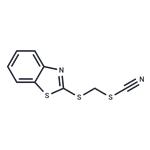- Benthiazole
-

- $58.00 / 1mg
-
2024-11-19
- CAS:21564-17-0
- Min. Order:
- Purity: 87.65%
- Supply Ability: 10g
- TCMTB
-

- $0.00 / 25kg
-
2024-10-24
- CAS:21564-17-0
- Min. Order: 25kg
- Purity: 30%;60%;80%
- Supply Ability: 200TONS
|
| | 2-(Thiocyanatomethylthio)benzothiazole Chemical Properties |
| | 2-(Thiocyanatomethylthio)benzothiazole Usage And Synthesis |
| Description | (Benzothiazol-2-ylthio)methyl thiocyanate (TCMTB) is a chemical compound classified as a benzothiazole. 2-(thiocyanomethylthio)benzothiazole is a a soil and seed treatment used to control various fungal and bacterial infections. It is moderately soluble in water, has a low volatility and is not expected to be persistent in soil systems. It is not eexpected to leach to groundwater. It has a pungent odour, is highly toxic to most aquatic species and moderately toxic to birds. 2-(thiocyanomethylthio)benzothiazole is highly toxic to humans via the oral route and is a recognised irritant.
| | Properties | TCMTB is an oily, flammable, red to brown liquid with a pungent odor that is very slightly soluble in water. It decomposes on heating producing hydrogen cyanide, sulfur oxides, and nitrogen oxides. The degradation products are 2-mercaptobenzothiazole (2-MBT) and 2-benzothiazolesulfonic acid. | | Approval | TCMTB is not an authorized plant protection product in the European Union.In Germany, Austria and Switzerland, no plant protection products containing this active substance are authorized. | | Chemical Properties | Brown Oil | | Physical properties | It is a viscous reddish liquid and is insoluble in vater, but
soluble in organic solvents such as acetone,dimethylformamide,cyclohexanone, benzene and xylene. It has a specific gravityof 1.38,a boiling point greater than 120℃ and a vapour pressure of about 0.05 torr. The supplier normally dissolves TCMTB in a mixture of organic solvents to form a concentrate. Emulsifiers
or surfactants may be added to the concentrate to improve the
stability of emulsions formed when the concentrate is diluted withwater.
TCMTB is sold commercially as 80% technical material under thetrade name "TCMTB" by Buckman Laboratories�,Which is the soleanufacturer of the material.The patented preparationinvolves a reaction of 2-mercaptobenzothiazole and
chloromethylthiocyanate,but confidential data obtained from Buckman Laboratories indicates another preparative method may now be used. | | History | The commercial use of TCMTB apparently had its origins in with Buckman Laboratories�����,Inc., of Memphis���,Tennessee. In thelate 1940's this company became involved in the search for
solutions to the problem of breaks in paper on high speed paperachines due to the formation of microbiological slime.rhecompany first developed the microbiocide BSM-11,a product
containing mercuric acetate and trichlorophenol, which seemed tof ind acceptance in the paper making industry.
However, in view of the potentiaL for adverse health and
environmental impacts from the use of mercury compounds,BuckmanLaboratories developed a 1ine of organosulphur compounds whichalso proved to be effective slime control agents."Alone���, or inconjunction with other active ingredients���,TCMTB is now found in avariety of Buckman products. | | Uses | 2-(Thiocyanatomethylthio)benzothiazole is an antimicrobial agent used as a substitute for chlorophenols in industrial applications. | | Uses | Wood preservative, marine biocide, fungicide. | | Application | 2-(Thiocyanatomethylthio)benzothiazole can be used as:- Industrial antimicrobial used instead of chlorophenols;
- Used as a wood preservative, marine biocide, and fungicide;
- Used as a contact fungicide for barley, cotton. corn, oats, rice, sorghum. sugar beets, safflower, and wheat;
- in seed treatments for cereals, corn, cotton, legumes, rice, sorghum, and sugar beets;
- as preservative in paints and leather production;
- Used as a wood preservative, biocide (pulp & paper mills, sewage systems), product preservative and slimicide (paper, leather, paint, carpet, textiles, wallpaper), and seed treatment pesticide.
| | Toxicology | There are few published studies on the toxicity of TCMTB or Busan1030. Confidential information received from Buckman Laboratoriesindicates that most of the toxicity studies on TCMTB and Busan
1030 have been carried out by private laboratories and that this data vas submitted to government agencies as part of the pesticideregistration process. "Unfortunately, this data is not available from Agriculture Canada, but has been requested by the
company from the B.C. Ministry of Environment and Parks' wasteManagement Branch . |
| | 2-(Thiocyanatomethylthio)benzothiazole Preparation Products And Raw materials |
|